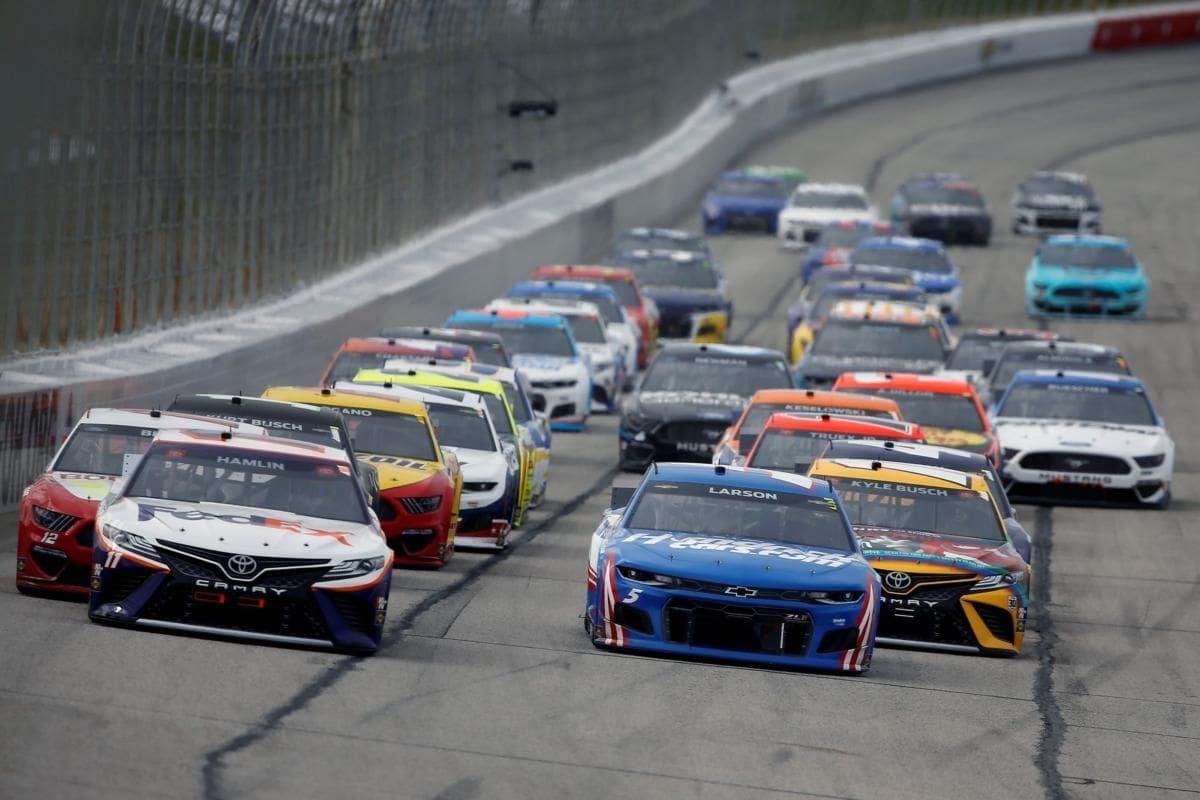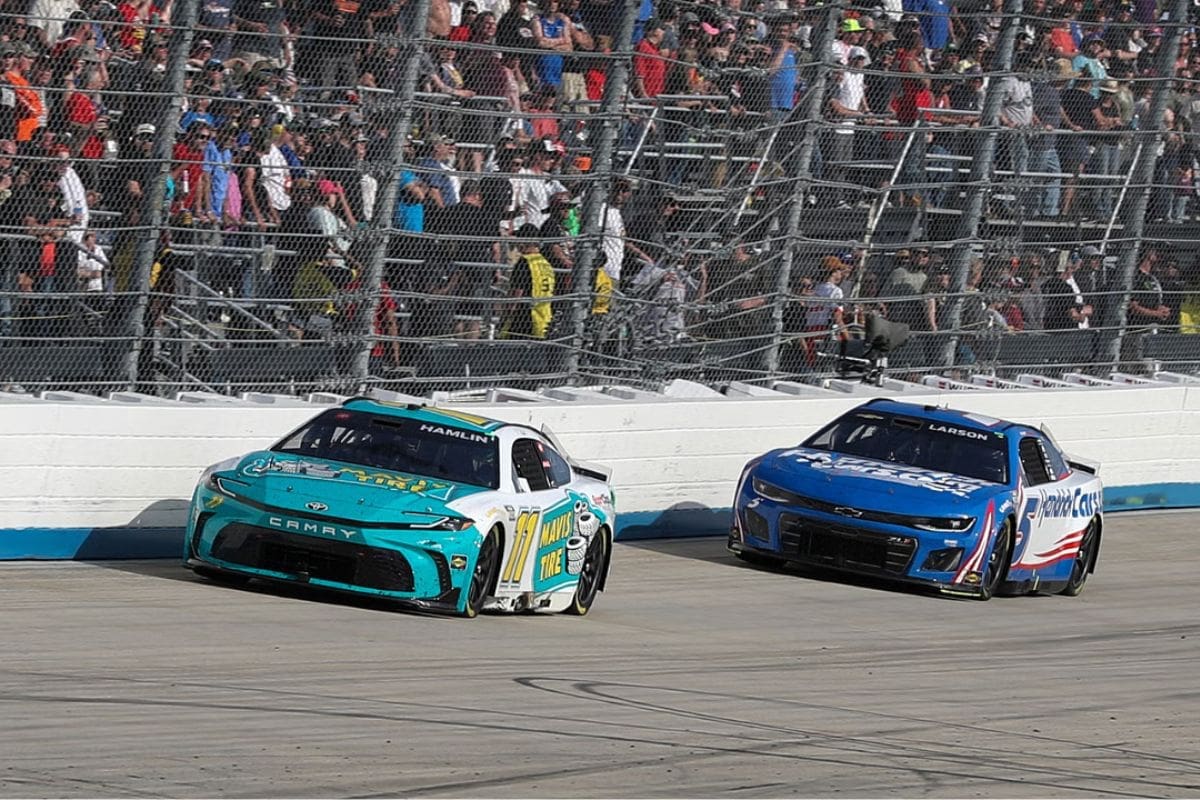Coca-Cola 600 Surprise Washout: The unexpected washout of the Coca-Cola 600 has raised significant questions about NASCAR’s readiness and strategic decision-making in the face of adverse weather conditions. Christopher Bell‘s win, achieved under the looming threat of rain, has not only highlighted the inherent unpredictability of motorsports but also emphasized NASCAR’s critical role in safeguarding the integrity of race outcomes. Are the current protocols sufficient to handle such disruptions, or is there a pressing need for more consistent and transparent governance?
Key Highlights
- NASCAR’s handling of the Coca-Cola 600 race interruption has intensified scrutiny on their governance and decision-making processes.
- The race’s sudden halt due to weather conditions significantly impacted standings and playoff eligibility, notably for driver Kyle Larson.
- Fans and sponsors expressed frustration over conflicting reports and the financial implications of the race stoppage.
- The event highlighted the need for NASCAR to balance safety, logistics, competitive integrity, and fan engagement during unforeseen disruptions.
- The decision-making process for handling race interruptions now sets a crucial precedent for future NASCAR events.
The Outcome and NASCAR’s Decision
The controversial decision by NASCAR officials to abruptly end the Coca-Cola 600 after Kyle Larson’s unexpected exit has sparked a heated debate over the integrity and future of the sport. The sudden end to what is often considered the crown jewel of NASCAR events left many fans and participants questioning the rationale behind such a move and its broader implications.
Kyle Larson, a prominent figure in the racing community, faced an unforeseen exit that not only dashed his hopes but also left a significant gap in the competition. The race, traditionally a proof of endurance and strategy, was cut short, leading to widespread discontent among fans who had invested emotionally and financially in the event. This decision, perceived by many as hasty and unwarranted, raises pressing questions about NASCAR’s decision-making processes.
In the immediate aftermath, social media platforms and discussion forums were flooded with reactions from fans, drivers, and analysts. The overarching sentiment was one of bewilderment and frustration. Many argued that NASCAR’s choice undermined the competitive spirit of the sport, highlighting a potential disconnect between the governing body and its audience. The abrupt end not only deprived fans of the full spectacle but also cast a shadow over the legitimacy of the results.
From an insider’s perspective, the decision may have been influenced by factors not immediately apparent to the public. Safety concerns, logistical challenges, and unforeseen circumstances often play crucial roles in such calls. However, the lack of transparent communication from NASCAR has only fueled speculation and dissatisfaction. As the dust settles, the organization must address these concerns head-on to restore faith and ensure the sport’s integrity remains intact.
Christopher Bell’s Victory and the Role of Weather
Christopher Bell’s victory in the rain-shortened Coca-Cola 600 highlighted the unpredictable nature of motorsport, where weather conditions can significantly alter the course and outcome of a race. The win marked Bell’s second triumph of the 2024 season, emphasizing his skill and adaptability in volatile conditions. However, this race was as much about the elements as it was about the driver’s expertise behind the wheel.
From the outset, the weather posed a significant challenge. Rain intermittently disrupted the race, causing multiple delays and ultimately leading to a premature end. Bell, driving for Joe Gibbs Racing, capitalized on the circumstances, maintaining a strategic position as the rain intensified. While his performance was commendable, the adverse weather played an undeniable role in curtailing the event, raising questions about race management and timing.
Bell’s ability to navigate the wet track with precision and poise highlighted his exceptional driving abilities. Yet, it also brought to light the inherent unpredictability of outdoor sports. The rain not only tested the drivers’ skills but also the resilience and decision-making skills of their teams. As the skies opened, pit strategies became a game of chess, with crews attempting to outmaneuver the unpredictable weather patterns.
The fans, however, were left with mixed feelings. While Bell’s victory added another achievement to his cap, the abrupt end due to weather left many yearning for a complete race experience. The role of weather in determining the outcome of the Coca-Cola 600 serves as a stark reminder of the uncontrollable variables in motorsport, where sometimes, nature has the final say.
Scrutiny on NASCAR and Other Players
NASCAR’s handling of recent events, including the controversial decision-making during the rain-shortened Coca-Cola 600 and the Ricky Stenhouse Jr. and Kyle Busch incident, has intensified scrutiny on the organization’s consistency and governance.
The Coca-Cola 600, one of NASCAR’s marquee events, was truncated due to inclement weather, leaving many fans and stakeholders questioning the adequacy of the contingency plans in place. The decision to call the race, while perhaps justified by safety concerns, has nonetheless sparked debates on whether alternative scheduling or more robust weather forecasting protocols could have averted the premature outcome.
Adding to the controversy, the Stenhouse-Busch altercation earlier in the month brought further attention to NASCAR’s adjudication processes. The incident, which saw heated exchanges both on and off the track, was met with what some perceive as inconsistent disciplinary action. This has raised concerns about the transparency and fairness of NASCAR’s governance.
The governing body, already under the microscope for its handling of the Coca-Cola 600, now faces heightened scrutiny to demonstrate a more consistent and equitable approach to rule enforcement.
Insiders suggest that NASCAR’s decision-making is often a balancing act between maintaining the integrity of the sport and ensuring the safety and engagement of its participants and fans. However, the recent events have laid bare the challenges inherent in this balancing act. With fans and competitors airing grievances, NASCAR’s leadership is at a critical point.
The Decision-Making Process and Reactions
Amid the escalating controversy, officials faced a pivotal moment when they decided to halt the Coca-Cola 600, citing an assessment that the track conditions would not improve until the early hours of the morning. This decision, inherently intricate and laden with potential repercussions, demanded evaluation of safety, logistics, and fan expectations.
The judgment to cease the event was influenced by multiple factors, including the safety of the drivers and the integrity of the race. However, the decision also sparked a wave of reactions from different stakeholders, each with their own perspective on the abrupt termination of the race.
Hey @jeff_gluck, here’s a pretty damn dry quiet track pic at 1:11 AM ET. pic.twitter.com/k7sdaqXc29
— Toby Christie (@Toby_Christie) May 27, 2024
Fans, who had eagerly anticipated the longest race of the year, expressed frustration when images surfaced depicting the track in a seemingly dry state, contradicting NASCAR’s official stance. This discrepancy fueled conjecture and dissatisfaction, particularly on social media platforms where fans voiced their discontent.
Teams, on the other hand, exhibited mixed reactions. Some teams endorsed the safety-centric approach, while others questioned the transparency and timeliness of the decision-making process. The balance between ensuring driver safety and maintaining competitive fairness was scrutinized, highlighting the delicate nature of such decisions.
“I think, too, for me, I was in the motor home, and I was told that they’re going to call the drivers in 15 minutes, so I got my jacket on, I was going out the door.”
“But you’re never quite sure, too. I’d be willing to bet on the part of the track there was either weeping and a lot of things — that was a heavy rain, and I’d be willing to bet they concluded they weren’t going to be able to get it dry.” – Joe Gibbs
Joe Gibbs said he was told NASCAR planned on calling the drivers in “15 minutes” when the race was called.
“I think, too, for me, I was in the motor home, and I was told that they’re going to call the drivers in 15 minutes, so I got my jacket on, I was going out the door.“
— Austin Konenski (@AustinKonenski) May 27, 2024
Sponsors, too, felt the impact of the washout. The premature end of the race meant lost opportunities for brand visibility, which could translate into significant financial ramifications.
Impact on Standings and Future Implications
The sudden halt of the Coca-Cola 600 has unquestionably reshaped the competitive landscape, profoundly impacting the standings and casting a shadow of uncertainty over the future playoff eligibility of drivers like Kyle Larson. As the rain-soaked event was called off, the potential outcomes that could have unfolded later in the race were abruptly hindered, altering the dynamics of the points table in a significant manner. This decision has not only immediate repercussions but also far-reaching implications for the season’s progression.
Kyle Larson, a formidable contender, now finds himself at a crossroads. With the race’s premature end, Larson’s standing has been negatively affected, potentially jeopardizing his playoff hopes. The possibility of NASCAR granting Larson a waiver remains a critical point of discussion, as it could either alleviate or worsen his current predicament. This situation highlights the delicate balance of competitive integrity and regulatory discretion that NASCAR must navigate moving forward.
Starting from P30, Keselowski managed to finish second when the race was called. Naturally, he appeared devastated by its premature end.
“We ran down the 20 car twice and didn’t get to see it play out. It slipped through our fingers. I think we would have won had we run the Coke 600, but we ran the Coke 350. I’m bummed for our team, but the weather is what the weather is.” – Keselowski, As reported by ESPN
- Standings Shifts: The sudden halt has resulted in unexpected shifts in the points table, with some drivers gaining an advantage while others, like Larson, face setbacks.
- Playoff Eligibility: Larson’s playoff eligibility is now in question, hinging on NASCAR’s potential waiver decision.
- Driver Morale: The decision’s impact on driver morale and team strategy cannot be overstated, as it introduces a layer of unpredictability.
- Future Precedents: The handling of this event sets a precedent for how future race disruptions might be managed, influencing both regulatory actions and team expectations.
I remember this being done in the 1997 Coca-Cola 600. That race was heavily delayed due to rain, and as it was getting really late, #NASCAR opted to shorten the race to 333 laps mid-race. https://t.co/t5ZEkvZyOa
— Toby Christie (@Toby_Christie) May 27, 2024
News in Brief: Coca-Cola 600 Surprise Washout
The premature resolution of the Coca-Cola 600 due to adverse weather conditions highlights the intricacies inherent in motorsport event management.
Christopher Bell’s victory amidst strategic pit decisions emphasizes the crucial role of NASCAR in upholding the sport’s integrity.
The scrutiny of NASCAR’s governance and decision-making processes reveals a need for standardized protocols to address unforeseen disruptions, ensuring fair outcomes for competitors and maintaining the competitive balance vital for the sport’s future sustainability.
Our Reader’s Queries
Q. How many stages are in NASCAR Coca-Cola 600?
A. The Coca-Cola 600 stands out on the NASCAR Cup Series schedule as the sole race featuring four stages, deviating from the usual three-stage format.
Q. What happened at the Coca-Cola 600?
A. A lightning delay evolved into a heavy rainstorm, resulting in Christopher Bell’s victory in Sunday’s Coca-Cola 600 at Charlotte quad-oval track. Despite the race being called prematurely by NASCAR after completing 249 of the scheduled 400 laps, Bell’s performance warranted the win in the rain-shortened event.
Q. Was the Coca-Cola 600 rained out?
A. NASCAR Charlotte faced a delay as the rain-shortened Coca-Cola 600 concluded under a weather delay. In an update at 10:30 P.M. CT, NASCAR officially called the race, with Christopher Bell crowned the winner of the rain-shortened Coca-Cola 600.
ALSO READ: Coca-Cola 600 Payouts Near 10M Dollars in NASCAR’s Dominant Run



